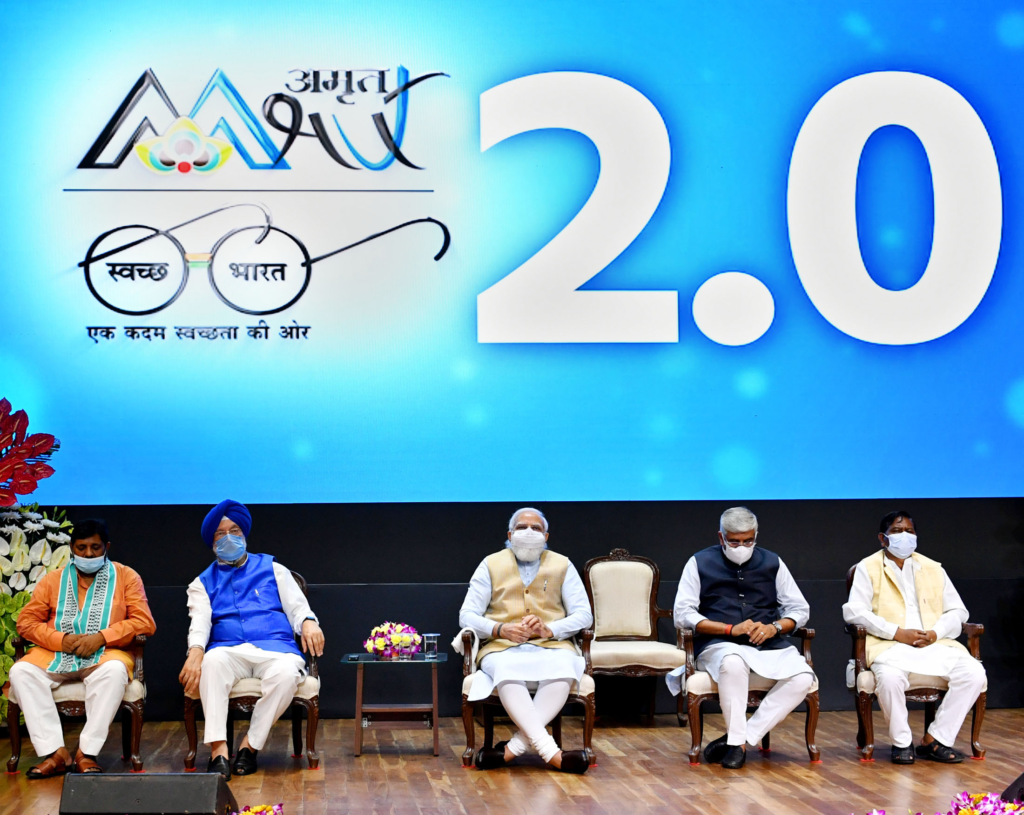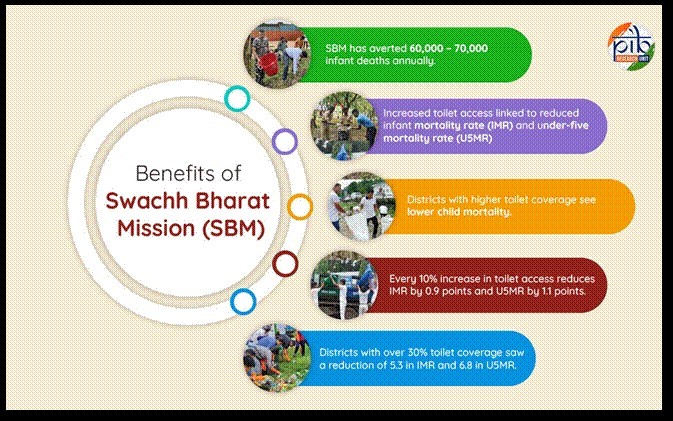
Origin
- In 2021, the Government of India launched its flagship five-year Swachh Bharat (Clean India) Mission-Urban 2.0 (SBM-U 2.0), committing to making all cities “garbage-free cities” (GFC’s) by 2026, while maintaining open-defecation free (ODF) status across 4,372 urban local bodies (ULB’s).
About
- The Swachh Bharat Mission (SBM), launched by the Government of India on October 2, 2014, has been a pivotal initiative aimed at improving sanitation, eliminating open defecation, and promoting cleanliness across the country.
- The mission’s first phase, Swachh Bharat Mission – Gramin (SBM-G) and Swachh Bharat Mission – Urban (SBM-U), was focused on achieving a Open Defecation Free (ODF) India by 2019.
- The successful completion of the first phase led to the launch of Swachh Bharat Mission 2.0 in 2020, which aims to build on the progress of the initial phase and address the next set of sanitation and cleanliness challenges.
Objectives of Swachh Bharat Mission 2.0
- Swachh Bharat Mission 2.0 is designed to further strengthen the efforts towards creating a clean and healthy India by focusing on the sustainability of ODF (Open Defecation Free) status, ensuring the management of waste, and promoting the cleanliness of public spaces. The mission also extends its focus to addressing environmental concerns related to sanitation and waste management.
Key objectives include
- Sustainability of ODF Status:
- Ensuring that rural and urban areas retain their Open Defecation Free status by maintaining clean and functional toilets.
- Solid Waste Management:
- Proper segregation, collection, treatment, and disposal of solid waste across urban and rural areas.
- Liquid Waste Management:
- Addressing the challenges of wastewater treatment and improving the management of liquid waste in urban and rural areas.
- Behavioural Change:
- Encouraging cleanliness habits and hygiene practices at the grassroots level, with a strong focus on sustainability and community ownership.
- Odour-free Public Spaces:
- Ensuring clean and safe public spaces, particularly toilets, parks, and markets.

Key Features of Swachh Bharat Mission 2.0
Swachh Bharat Mission 2.0 introduces several new features and expands upon the framework of the first phase, ensuring that cleanliness and sanitation are given long-term importance in India’s development.
- ODF+ and ODF++
- The ODF+ (Open Defecation Free Plus) and ODF++ categories are new milestones under SBM 2.0. These categories aim to improve the quality of sanitation and the infrastructure of toilets that were built during the first phase. These goals focus on ensuring:
- Functional and well-maintained toilets.
- Community participation in sustaining ODF status.
- Ensuring hygiene practices like handwashing with soap, waste treatment, and disposal.
- The ODF+ (Open Defecation Free Plus) and ODF++ categories are new milestones under SBM 2.0. These categories aim to improve the quality of sanitation and the infrastructure of toilets that were built during the first phase. These goals focus on ensuring:
- ODF++ is a higher level of achievement that requires the implementation of specific standards in waste management and maintaining ODF status at the district level.
- Solid Waste Management
- A major component of SBM 2.0 is tackling solid waste management in urban areas. Urban India generates millions of tons of solid waste every year, and inadequate waste management leads to pollution and health hazards.
- SBM 2.0 focuses on:
- Waste segregation at source:
- Encouraging households and businesses to segregate waste into biodegradable and non-biodegradable categories.
- Waste processing:
- Promoting composting, biogas production, and other waste-to-energy technologies.
- Waste collection and disposal:
- Ensuring proper door-to-door waste collection, ensuring waste is collected efficiently, and transported to processing plants.
- Promoting recycling:
- Encouraging waste segregation, recycling, and reducing the amount of waste sent to landfills.
- Waste segregation at source:
- Liquid Waste Management
- Liquid waste management is a critical aspect of SBM 2.0, particularly in the context of rural areas and smaller towns where wastewater treatment infrastructure is limited.
- The mission emphasizes:
- Setting up sewerage systems and wastewater treatment plants.
- Promoting decentralized approaches to managing wastewater in rural areas.
- Ensuring that liquid waste is safely treated and reused where possible, like for irrigation.
- Beautification of Public Spaces
- SBM 2.0 places significant importance on making urban and rural spaces not just clean but also aesthetically pleasing. This includes:
- Upgrading public toilets:
- Ensuring toilets are clean, hygienic, and accessible for everyone.
- Waste bins in public spaces:
- Providing waste bins in public areas like markets, parks, and roadsides to encourage proper disposal.
- Street cleaning:
- Ensuring regular cleaning of streets, roads, and marketplaces, especially in tourist areas and crowded places.
- Upgrading public toilets:
- SBM 2.0 places significant importance on making urban and rural spaces not just clean but also aesthetically pleasing. This includes:
- Awareness and Behavioral Change
- One of the main goals of SBM 2.0 is to create a behavioral shift towards cleanliness and sanitation. Awareness campaigns and community engagement are key to changing how people perceive sanitation and waste.
- The “Swachhata Hi Seva” campaign is one such initiative that has been organized across India to spread awareness about sanitation and waste management practices.
- Educational programs are conducted at the grassroots level, schools, and colleges to instill hygiene habits and foster the participation of citizens.
Budget and Financial Support
- The Swachh Bharat Mission 2.0 is supported with a substantial budget allocated by the Indian government. The central government has earmarked a considerable amount for the implementation of the mission in rural and urban areas. Funds are provided to local governments and municipal bodies to develop infrastructure related to sanitation, wastewater treatment, solid waste management, and capacity building.
Challenges and Roadblocks
Despite the significant progress made under the first phase of Swachh Bharat Mission, there remain several challenges in SBM 2.0 that need to be addressed:
- Sustainability of ODF Status
- While India has made remarkable strides in achieving an Open Defecation Free status, the real challenge lies in ensuring that the constructed toilets remain functional and are used regularly by communities.
- Waste Segregation
- Although waste segregation at the source is being promoted, many urban and rural areas still lack the infrastructure for the proper management of segregated waste. It requires coordinated efforts between citizens and local authorities to ensure segregation.
- Inadequate Infrastructure
- Many areas, particularly rural India, still lack adequate infrastructure to support solid and liquid waste management, such as sewage systems, wastewater treatment plants, and waste processing facilities. This needs substantial investment and long-term planning.
- Behavioral Change and Awareness
- Changing long-standing habits and practices in waste disposal, sanitation, and cleanliness requires continuous awareness campaigns and community participation. It is essential to engage citizens at all levels to foster a sense of ownership and responsibility.
Achievements of Swachh Bharat Mission 1.0
- Open Defecation Free India:
- As of 2019, over 100 million toilets were constructed in rural India, and many villages and districts were declared ODF.
- Improved Public Health:
- The construction of toilets and improvement of sanitation facilities have had a direct impact on public health, reducing diseases related to poor sanitation like cholera and diarrhea.
- Behavioral Change:
- There was a marked increase in awareness regarding sanitation and hygiene, especially in rural areas. The mission encouraged families to take ownership of their sanitation needs.
- Increased Participation:
- Community involvement was encouraged through public awareness campaigns and local leadership. Local governments and communities actively participated in keeping their surroundings clean.
Implementation Strategy
Swachh Bharat Mission 2.0 employs a multi-stakeholder approach to achieve its goals, involving:
- Central Government:
- Funding, coordination, and policy direction.
- State Governments:
- Implementation and monitoring of the mission’s objectives within their regions.
- Urban Local Bodies (ULBs) and Rural Local Bodies (RLBs):
- Execution of waste management systems and sanitation programs at the local level.
- Community Participation:
- Engaging citizens in maintaining hygiene and cleanliness, segregating waste, and using sanitation facilities.
- Private Sector and NGOs:
- Providing technological solutions for waste management, sanitation infrastructure, and behavioral change programs.
Conclusion
- Swachh Bharat Mission 2.0 is a vital step in ensuring the long-term sustainability of sanitation and waste management practices in India. While the mission has already made a significant impact by improving sanitation and promoting cleanliness, SBM 2.0 goes beyond just creating infrastructure. It focuses on ensuring that the gains of the previous phase are maintained, waste is managed efficiently, and citizens are continuously engaged in maintaining a clean and healthy environment.
- The success of Swachh Bharat Mission 2.0 will depend on consistent efforts from the government, local bodies, and the public.
Continued awareness campaigns, investment in infrastructure, and active community participation will be critical to achieving the ultimate goal: a clean, sustainable, and hygienic India for generations to come.



















